Safety
Shut off gas before beginning
Observe local codes.
Hire a a qualified technician if in doubt.
Test gas lines before and after restoring supply.
|
Time Required: 4 hrs.
Level of difficulty

|
Required Tools
Wrench
Nut driver
Screw driver
Level
Pry bar
Teflon tape or pipe dope
Liquid soap
LP conversion kit*
* If required
|
|
Replacing a Gas Stove
After enough repair bills, it's probably time to replace that old gas stove. The procedure is straight forward, unless you have LP gas.
Units are delivered ready to go for natural gas but require several modifications to convert to bottled gas. It's not too difficult, just be sure that you follow all of the instructions that come with the conversion kit for your model range.
Stove installation is best done by a qualified service technician, though if you are confident, you can do it yourself. Be sure to obey local codes and ordinances to ensure that homeowner installation is permitted.
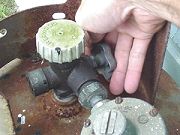 Step 1:
Step 1:
You need to disconnect and remove the old unit. This includes both the gas and the electric. Before you get started, shut of the gas line. Close the valve, located either in the basement or at the tank.
Step 2:To pull the plug, you will need to move the unit away from the wall. First lay down a piece of plywood to keep from gouging or scratching the floor.
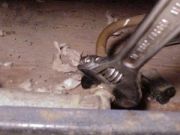 Step 3:
Step 3:
At the base of the stove, remove the cover plate with a screwdriver. If you have old copper tubing, you will first need to disconnect the line at the fitting to the stove.
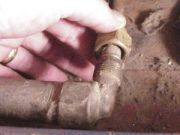
Step 4:
Loosen the nut and slide this back. This is a flared copper type fitting.
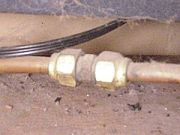 Step 5:
Step 5:
Now carefully move the range forward on top of the plywood, avoiding damage to the gas line. Climb in back of the unit and disconnect the old gas line at the coupling, using two wrenches. Be careful not to crimp the cooper piping.
Skip to step 11 if not converting to liquid propane
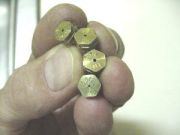
Step 6:
To prepare the new unit for LP gas you need to adjust several items. First you will need to replace the range orifices or spuds. These are individually sized with marks and colors.
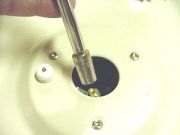 Step 7:
Step 7:
Using a nut driver, loosen the old spud and replace with the new one.The trick to keeping from dropping the spud down inside the range is to use a small piece of aluminum foil between the driver and the spud. This should provide enough "grip".
If you do drop one down inside, you'll need torx wrenches to disassemble the burner units and get inside.
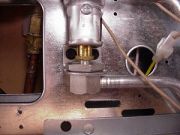 Step 8:
Step 8:
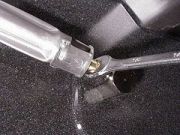 The oven orifices need to be adjusted. Using an open-end wrench, tighten down the brass fitting on the oven burner valve.
The oven orifices need to be adjusted. Using an open-end wrench, tighten down the brass fitting on the oven burner valve.
Step 9:
There may be two orifices, one for the broiler and one for the main oven burner.
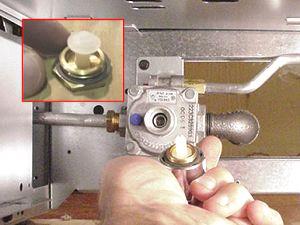 Step 10:
Step 10:
You will need to reverse the plastic pin in the regulator underneath the range. Remove the hex nut and flip the plastic pin and reassemble the nut.
Do not over tighten!
The last step is to open the air shutters on each burner as per directions included with the range conversion kit.
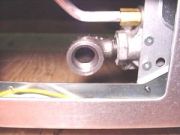 Step 11:
Step 11:
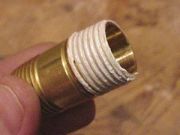 To connect the gas line, you will need to purchase a new connector line. Bring the old connector to the store as you will have to match up pipe thread at the stove with the compression fittings on the old gas line.
To connect the gas line, you will need to purchase a new connector line. Bring the old connector to the store as you will have to match up pipe thread at the stove with the compression fittings on the old gas line.
Step 12:
To make the connection, coat the threads with pipe dope compound or Teflon tape as per local gas codes.
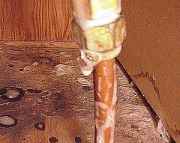 Step 13:
Step 13:
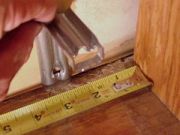 Tighten the fitting and test by applying very soapy water. (No matches please!) If it bubbles in a few seconds, you have a leak. Try again!
Tighten the fitting and test by applying very soapy water. (No matches please!) If it bubbles in a few seconds, you have a leak. Try again!
Step 14:
Mount the range's anti-tip bracket to the wall behind the stove. Simply screw this in place as per directions included with the range.
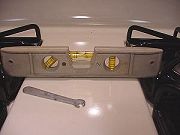 Step 15:
Step 15:
Move the new stove in place and level the legs. While there is a hex head inside the unit, it is easier to use a pry bar and slightly lift the unit and turn the legs from beneath.
Finally, don't forget to open the gas line. If there is any smell of gas, shut off the supply and call a qualified service technician.
Article and images Copyright © 2000 - InsideSpaces. All rights reserved.Reprinted with permission.
Disclaimer: The staff of Appliance411 does not necessarily agree with the opinions expressed in this article. This information is presented for reference only.


